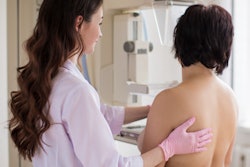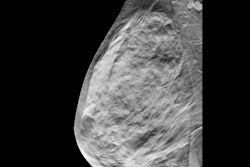
Women who have both benign breast disease and markedly dense breast tissue have more than a twofold higher risk of breast cancer, say researchers from South Korea in a study of over 3.9 million women published May 17 in Radiology.
A team led by Boyoung Park, PhD, from Hanyang University in Seoul found that the 10-year risk of breast cancer was 1.1% in women with benign breast disease and fatty breast tissue. That risk rose to 2.64% in women with both benign breast disease and extremely dense breasts.
"Our findings strengthen the evidence suggesting that benign breast disease and breast density are important factors that should be carefully considered when stratifying breast cancer risk and should be incorporated in future breast cancer risk models," Park and colleagues wrote.
Benign breast disease refers to noncancerous breast lumps, cysts, or nipple discharge. While this is a common condition for women, it is considered a risk factor for breast cancer in women. Higher breast density found on mammography is another risk factor.
While the two factors individually are well-established risk factors, few studies have investigated their combined effects on breast cancer risk. Park and colleagues wanted to investigate this among women in South Korea, which offers population-based screening mammography for all women ages 40 and over.
The study authors wrote that better understanding of breast cancer risk factors would help identify Asian women who could benefit from supplemental screening strategies and account for differences in breast density between Asian and Western populations. They also noted that there is a scarce amount of information about risk-based screening in the Asian population.
The team looked at retrospective data from 3,911,348 women with an average age of 53 years.
During follow-up, which had a median of 10.6 years, 58,321 women developed breast cancer. At screening, 10,729 (18.4%) cases of benign breast disease were detected among women who developed breast cancer.
The researchers found that breast cancer risk was 1.36% in women with fatty breast tissue and 3.2% in women with extremely dense breasts.
They also found that women with extremely dense breasts and benign breast disease had the greatest risk of breast cancer, as indicated in the table below.
| Cancer risk by breast tissue characteristics | |
| Breast tissue characteristics | Cancer risk (hazard ratio) |
| Extremely dense breasts and benign breast disease | 2.75 |
| Extremely dense breasts and without benign breast disease | 2.28 |
| Benign breast disease and fatty breasts | 1.49 |
Park and colleagues wrote that their findings could assist future research in developing a risk-based screening strategy via mammography, with a focus on high-risk groups such as women with benign breast disease and dense breasts. They also wrote that supplemental screening methods using MRI or ultrasound could further help these women, though more studies are needed.
"Future research should assess the association stratified by histologic classifications of benign breast disease and determine whether the relationship deviates by molecular subtypes of breast cancer, where the magnitude of association may differ," they added.




















